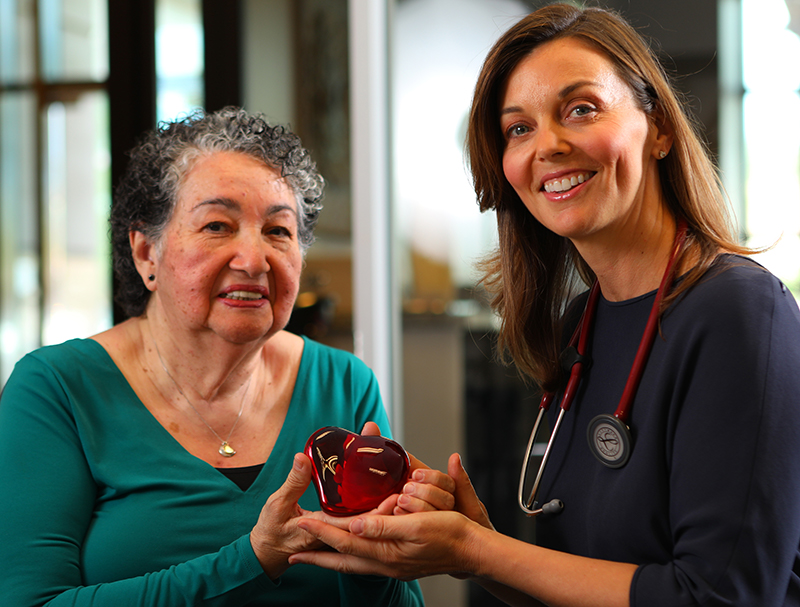How the heart works
Your heart is a strong, muscular organ situated slightly to the left of your chest. It pumps blood to all parts of the body through a network of blood vessels by continuously expanding and contracting. On average, your heart will beat 100,000 times and pump about 2,000 gallons of blood each day.
The heart is divided into a right and left side, separated by a septum. Each side has an atrium (which receives blood as it enters) and a ventricle (from which blood is pumped out). The heart has a total of four chambers: right atrium, right ventricle, left atrium and left ventricle.
The right side of the heart collects oxygen-depleted blood and pumps it to the lungs, through the pulmonary arteries, so that the lungs can refresh the blood with a fresh supply of oxygen.
The left side of the heart receives oxygen-rich blood from the lungs, then pumps blood out to the rest of the body's tissues, through the aorta.
Valves maintain direction of blood flow
As the heart pumps blood, a series of valves open and close tightly. These valves ensure that blood flows in only one direction, preventing backflow.
- The tricuspid valve is situated between the right atrium and right ventricle.
- The pulmonary valve is between the right ventricle and the pulmonary artery.
- The mitral valve is between the left atrium and left ventricle.
- The aortic valve is between the left ventricle and the aorta.

Each heart valve, except for the mitral valve, has three flaps (leaflets) that open and close like gates on a fence. The mitral valve has two valve leaflets.
The circulatory system
While the heart and lungs are the largest organs of the circulatory system, the blood vessels are the longest. This extended network of stretchy tubes circulates blood throughout the body. Laid end-to-end, your body's blood vessels would extend about 60,000 miles. That's more than 21 road trips between New York and Los Angeles!
Arteries (along with smaller arterioles and microscopic capillaries) convey oxygen- and nutrient-rich blood to the body's tissues. In turn, veins bring nutrient-depleted blood back to the heart. Along the way, blood is routed through the kidneys and liver, as well, filtering waste products from the blood.
Electrical impulses keep the beat
The heart's four chambers pump in an organized manner with the help of electrical impulses that originate in the sinoatrial node (also called the "SA node"). Situated on the wall of the right atrium, this small cluster of specialized cells is the heart's natural pacemaker, initiating electrical impulses at a normal rate.
The impulse spreads through the walls of the right and left atria, causing them to contract, forcing blood into the ventricles. The impulse then reaches the atrioventricular (AV) node, which acts as an electrical bridge for impulses to travel from the atria to the ventricles. From there, a pathway of fibers (the HIS-Purkinje network) carries the impulse into the ventricles, which contract and force blood out of the heart.
Heart anatomy: By the numbers
1. Superior vena cava: Receives blood from the upper body; delivers blood into the right atrium.
2. Inferior vena cava: Receives blood from the lower extremities, pelvis and abdomen, and delivers blood into the right atrium.
3. Right atrium: Receives blood returning to the heart from the superior and inferior vena cava; transmits blood to the right ventricle, which pumps blood to the lungs for oxygenation.
4. Tricuspid valve: Allows blood to pass from the right atrium to the right ventricle; prevents blood from flowing back into the right atrium as the heart pumps (systole).
5. Right ventricle: Receives blood from the right atrium; pumps blood into the pulmonary artery.
6. Pulmonary valve: Allows blood to pass into the pulmonary arteries; prevents blood from flowing back into the right ventricle.
7. Pulmonary arteries: Carry oxygen-depleted blood from the heart to the lungs.
8. Pulmonary veins: Deliver oxygen-rich blood from the lungs to the left atrium of the heart.
9. Left atrium: Receives blood returning to the heart from the pulmonary veins.
10. Mitral valve: Allows blood to flow into the left ventricle; prevents blood from flowing back into the left atrium.
11. Left ventricle: Receives oxygen-rich blood from the left atrium and pumps blood into the aorta.
12. Aortic valve: Allows blood to pass from the left ventricle to the aorta; prevents backflow of blood into the left ventricle.
13. Aorta: Distributes blood throughout the body from the heart.